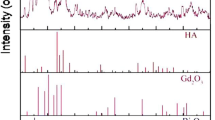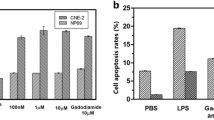Abstract
Multifunctional nanocomposites based on BaGdF5 nanoparticles (NPs) and metal phenolic network (MPN) have been engineered as novel contrast agents for potential applications in X-ray computed tomography, magnetic resonance and luminescence imaging. The BaGdF5@MPN nanocomposites were synthesized at room temperature by coating BaGdF5 NPs with europium-phenolic network, which was obtained by the coordination of europium (III) with tannic acid (TA). The in vitro cytotoxicity assays against HepG2 cells revealed that the BaGdF5@MPN nanocomposites presented better cytocompatibility and lower cytotoxity than pure BaGdF5 NPs. In addition, vivid red and green luminescence can be observed by confocal laser scanning microscope (CLSM) from the BaGdF5@MPN nanocomposites laden HepG2 cells under the excitation of UV (390 nm) and visible light (440 nm), respectively. The longitudinal relaxivity value (r1) of the nanocomposites was 2.457 mM−1s−1. Moreover, the nanocomoposites exhibited X-ray computed tomography (CT) and T1-weighted magnetic resonance (MR) imaging capacities, and the intensities of the enhanced signals of in vitro CT and MR images were proportional to the concentrations of the nanocomposites. These results indicated that the as-prepared BaGdF5@MPN nanocomposites are promising contrast agents for CT/MR/luminescence imaging.
Graphical Abstract








Similar content being viewed by others
References
Weissleder R, Pittet MJ. Imaging in the era of molecular oncology. Nature. 2008;452:580–9.
Kircher MF, Willmann JK. Molecular body imaging: MR imaging, CT, and US. Part I. Principles. Radiol. 2012;263:633–43.
Kalender WA. X-ray computed tomography. Phys Med Biol. 2006;51:R29–43.
Lusic H, Grinstaff MW. X-ray-computed tomography contrast agents. Chem Rev. 2013;113:1641–66.
Lusic H, Grinstaff MW. Comparison of different body size parameters for individual dose adaptation in body CT of adults. Radiology. 2005;236:565–71.
Leach MO. Breast cancer screening in women at high risk using MRI. NMR Biomed. 2009;22:17–27.
Hu H, Cheng KL, Xu XQ, Wu FY, Tyan YS, Tsai CH, et al. Predicting the prognosis of oral tongue carcinoma using a simple quantitative measurement based on preoperative MR imaging: tumor thickness versus tumor volume. Am J Neuroradiol. 2015;36:1338–42.
Burbach JP, Kleijnen JP, Reerink O, Seravalli E, Philippens ME, Schakel T, et al. Inter-observer agreement of MRI-based tumor delineation for preoperative radiotherapy boost in locally advanced rectal cancer. Radiotherapy Oncol. 2016;118:399–407.
Thomas JA. Optical imaging probes for biomolecules: an introductory perspective. Chem Soc Rev. 2015;44:4494–500.
Sutton EJ, Henning TD, Pichler BJ, Bremer C, Daldrup-Link HE. Cell tracking with optical imaging. Eur. Radiol. 2008;18:2021–32.
Tang YH, Zhang CF, Wang JX, Lin XJ, Zhang L, Yang Y, et al. MRI/SPECT/Fluorescent tri-modal probe for evaluating the homing and therapeutic efficacy of transplanted mesenchymal stem cells in a rat ischemic stroke model. Adv Funct Mater. 2015;25:1024–34.
Lobatto ME, Calcagno C, Millon A, Senders ML, Fay F, Robson PM, et al. Atherosclerotic plaque targeting mechanism of long-circulating nanoparticles established by multimodal imaging. ACS Nano. 2015;9:1837–47.
Cherukula K, Lekshmi KM, Uthaman S, Cho K, Cho CS, Park IK. Multifunctional inorganic nanoparticles: recent progress in thermal therapy and imaging. Nanomaterials. 2016;6:76–101.
Yu SB, Watson AD. Metal-based X-ray contrast media. Chem Rev. 1999;99:2353–77.
Yang DM, Dai YL, Liu JH, Zhou Y, Chen YY, Li CH, et al. Ultra-small BaGdF5-based upconversion nanoparticles as drug carriers and multimodal imaging probes. Biomaterials. 2014;35:2011–23.
Zhang H, Wu HX, Wang J, Yang Y, Wu DM, Zhang YJ, et al. Graphene oxide-BaGdF5 nanocomposites for multi-modal imaging and photothermal therapy. Biomaterials. 2015;42:66–77.
Zeng SJ, Tsang MK, Chan CF, Wong KL, Hao JH. PEG modified BaGdF5:Yb/Er nanoprobes for multi-modal upconversion fluorescent, in vivo X-ray computed tomography and biomagnetic imaging. Biomaterials. 2012;33:9232–8.
Rodriguez-Contreras A, Marques-Calvo MS, Gil FJ, Manero JM. Modification of titanium surfaces by adding antibiotic-loaded PHB spheres and PEG for biomedical applications. J Mater Sci Mater Med. 2016;27:124–38.
Hatakeyama H, Akita H, Harashima H. A multifunctional envelope type nano device (MEND) for gene delivery to tumours based on the EPR effect: a strategy for overcoming the PEG dilemma. Adv Drug Delivery Rev. 2011;63:152–60.
Hatakeyama H, Akita H, Harashima H. The Polyethyleneglycol dilemma: advantage and disadvantage of PEGylation of liposomes for systemic genes and nucleic acids delivery to tumors. Biol Pharm Bull. 2013;36:892–9.
Hama S, Itakura S, Nakai M, Nakayama K, Morimoto S, et al. Overcoming the polyethylene glycol dilemma via pathological environment-sensitive change of the surface property of nanoparticles for cellular entry. J. Control Release. 2015;206:67–74.
Ejima H, Richardson JJ, Liang K, Best JP, van Koeverden MP, Such GK, et al. One-step assembly of coordination complexes for versatile film and particle engineering. Science. 2013;341:154–7.
Ejima H, Richardson JJ, Caruso F. Phenolic film engineering for template-mediated microcapsule preparation. Polymer J. 2014;46:452–9.
Guo JL, Ping Y, Ejima H, Alt K, Meissner M, Richardson JJ, et al. Engineering multifunctional capsules through the assembly of metal-phenolic networks. Angew Chem Int Ed Engl. 2014;53:5546–51.
Guo JL, Wang XW, Henstridge DC, Richardson JJ, Cui JW, Sharma A, et al. Nanoporous metal-phenolic particles as ultrasound imaging probes for hydrogen peroxide. Adv Healthcare Mater. 2015;4:2170–5.
Ping Y, Guo JL, Ejima H, Chen X, Richardson JJ, Sun HL, et al. pH-responsive capsules engineered from metal-phenolic networks for anticancer drug delivery. Small. 2015;11:2032–6.
Liang HS, Li J, He Y, Xu W, Liu SL, Li Y, et al. Engineering multifunctional films based on metal-phenolic networks for rational pH-responsive delivery and cell imaging. ACS Biomater Sci Eng. 2016;2:317–25.
Bünzli JCG. On the design of highly luminescent lanthanide complexes. Coordin Chem Rev. 2015;293–4:19–47.
Ju Q, Tu DT, Liu YS, Li RF, Zhu HM, Chen JC, et al. Amine-functionalized lanthanide-doped KGdF4 nanocrystals as potential optical/magnetic multimodal bioprobes. J Am Chem Soc. 2012;134:1323–30.
Zhang L, Liang S, Liu RQ, Yuan TM, Zhang SL, Xu ZS, et al. Facile preparation of multifunctional uniform magnetic microspheres for T1-T2 dual modal magnetic resonance and optical imaging. Col Surf B Biointerf. 2016;144:344–54.
Zhou B, Jing X, Li J, Xu Wei, Liu SL, Li Y, et al. Vacuum-assisted layer-by-layer electrospun membranes: antibacterial and antioxidative applications. RSC Adv. 2014;4:54517–24.
Sahiner N, Sagbas S, Aktas N. Single step natural poly(tannic acid) particle preparation as multitalented biomaterial. Mat Sci Eng C. 2015;49:824–34.
Xu CF, Ma M, Yang LW, Zeng SJ, Yang QB. Upconversion luminescence and magnetic properties of ligand-free monodisperse lanthanide doped BaGdF5 nanocrystals. J Lumin. 2011;131:2544–9.
Lin DH, Xing BS. Tannic acid adsorption and its role for stabilizing carbon nanotube suspensions. Environ Sci Technol. 2008;42:5917–23.
Hoo CM, Starostin N, West P, Mecartney ML. A comparison of atomic force microscopy (AFM) and dynamic light scattering (DLS) methods to characterize nanoparticle size distributions. J Nanopart Res. 2008;10:89–96.
Abdesselem M, Schoeffel M, Maurin I, Ramodiharilafy R, Autret G, Clement O, et al. Multifunctional rare-earth vanadate nanoparticles: luminescent labels, oxidant sensors, and MRI contrast agents. ACS Nano. 2014;8:11126–37.
Shao GS, Han RC, Ma Y, Tang MX, Xue FM, Sha YL, et al. Bionanoprobes with excellent two-photon-sensitized Eu3+ luminescence properties for live cell imaging. Chem Eur J. 2010;16:8647–51.
Pan YF, Zheng A, Hu FZ, Xiao HN. Copolymers of styrene with a quaternary europium complex. J Appl Polym Sci. 2006;100:1506–10.
Liu RQ, Liang S, Jiang C, Zhang L, Yuan TM, Li PH, et al. Smart polymeric particle encapsulated gadolinium oxide and europium: theranostic probes for magnetic resonance/optical imaging and antitumor drug delivery. J Mater Chem B. 2016;4:1100–07.
Xiao LS, Mertens M, Wortmann L, Kremer S, Valldor M, Lammers T, et al. Enhanced in vitro and in vivo cellular imaging with green tea coated water-soluble iron oxide nanocrystals. ACS Appl Mater Interfaces. 2015;7:6530–40.
Majeed S, Shivashankar SA. Rapid, microwave-assisted synthesis of Gd2O3 and Eu:Gd2O3 nanocrystals: characterization, magnetic, optical and biological studies. J Mater Chem B. 2014;2:5585–93.
Acknowledgements
This work was supported by the National Natural Science Foundation of China (Grant Nos. 51573039, 81171386 and 31500773) and Science and Technology Key Projects of Shenzhen (No. JCYJ20150401150223643).
Author information
Authors and Affiliations
Corresponding authors
Ethics declarations
Conflict of interest
The authors declare that they have no competing interests.
Additional information
Wei Zhu and Shuang Liang have contributed equally to this work.
Rights and permissions
About this article
Cite this article
Zhu, W., Liang, S., Wang, J. et al. Europium-phenolic network coated BaGdF5 nanocomposites for tri-modal computed tomography/magnetic resonance/luminescence imaging. J Mater Sci: Mater Med 28, 74 (2017). https://doi.org/10.1007/s10856-017-5888-5
Received:
Accepted:
Published:
DOI: https://doi.org/10.1007/s10856-017-5888-5




